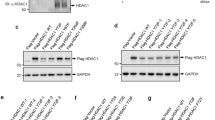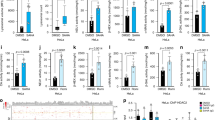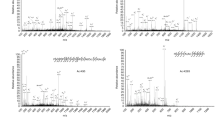Abstract
Reticulons are a family of highly conserved proteins, localized in the endoplasmic reticulum (ER) and involved in different cellular functions, such as intracellular membrane trafficking, apoptosis and nuclear envelope formation. The reticulon protein family consists of four members, but their specific functions are presently poorly understood. RTN-1C overexpression triggers apoptosis, regulating ER stress versus DNA damage-induced cell death in a mutually exclusive way. The different RTN isoforms share a C-terminal reticulon homology domain containing two hydrophobic segments and a 66-amino acid hydrophilic loop. In the C-terminal region of RTN-1C, a unique consensus sequence (GAKRH) has recently been identified, showing 100% identity with the DNA-binding domain of histone H4. In this study, we show that this sequence is essential for RTN-1C-mediated apoptosis. It is noteworthy that the lysine 204 present in this region is post-translationally modified by acetylation and that this event is associated with a significant decrease in histone deacetylase activity and contributes to RTN-1C binding to DNA. These data demonstrate a molecular mechanism by which RTN-1C controls apoptosis and indicate this protein to be a novel potential target for cancer therapy.
This is a preview of subscription content, access via your institution
Access options
Subscribe to this journal
Receive 50 print issues and online access
$259.00 per year
only $5.18 per issue
Buy this article
- Purchase on Springer Link
- Instant access to full article PDF
Prices may be subject to local taxes which are calculated during checkout






Similar content being viewed by others
Abbreviations
- FBS:
-
fetal bovine serum
- RTN-1C:
-
reticulon protein-1C
- ER:
-
endoplasmic reticulum
- HDAC:
-
histone deacetylase
- HAT:
-
histone acetylase
- TSA:
-
trichostatin A
- AA:
-
anacardic acid
- UPR:
-
unfolded protein responce
- CRT:
-
calreticulin
References
Anderson DJ, Hetzer MW . (2007). Nuclear envelope formation by chromatin-mediated reorganization of the endoplasmic reticulum. Nat Cell Biol 9: 1160–1166.
Babic I, Jakymiw A, Fujita DJ . (2004). The RNA binding protein Sam68 is acetylated in tumor cell lines, and its acetylation correlates with enhanced RNA binding activity. Oncogene 23: 3781–3789.
Blander G, Guarente L . (2004). The Sir2 family of protein deacetylases. Annu Rev Biochem 73: 417–435.
Brunet A, Sweeney LB, Sturgill JF, Chua KF, Greer PL, Lin Y et al. (2004). Stress-dependent regulation of FOXO transcription factors by the SIRT1 deacetylase. Science 303: 2011–2015.
Carrozza MJ, Utley RT, Workman JL, Côté J . (2003). The diverse functions of histone acetyltransferase complexes. Trends Genet 19: 321–329.
Di Sano F, Fazi B, Tufi R, Nardacci R, Piacentini M . (2007). Reticulon-1C acts as a molecular switch between endoplasmic reticulum stress and genotoxic cell death pathway in human neuroblastoma cells. J Neurochem 102: 345–353.
Eliseeva ED, Valkov V, Jung M, Jung MO . (2007). Characterization of novel inhibitors of histone acetyltransferases. Mol Cancer Ther 6: 2391–2398.
Freiman RN, Tjian R . (2006). Regulating the regulators: lysine modifications make their mark. Cell 112: 11–17.
Glozak MA, Seto E . (2007). Histone deacetylases and cancer. Oncogene 26: 5420–5432.
Gonzenbach RR, Schwab ME . (2008). Disinhibition of neurite growth to repair the injured adult CNS: focusing on Nogo. Cell Mol Life Sci 65: 161–176.
Gu W, Roeder RG . (1997). Activation of p53 sequence-specific DNA binding by acetylation of the p53 C-terminal domain. Cell 90: 595–606.
Gupta S, Meek K . (2005). The leucine rich region of DNA-PKcs contributes to its innate DNA affinity. Nucleic Acids Res 33: 6972–6981.
He W, Lu Y, Qahwash I, Hu XY, Chang A, Yan R . (2004). Reticulon family members modulate BACE1 activity and amyloid-beta peptide generation. Nat Med 10: 959–965.
Huber AB, Weinmann O, Brösamle C, Oertle T, Schwab ME . (2002). Patterns of Nogo mRNA and protein expression in the developing and adult rat and after CNS lesions. J Neurosci 22: 3553–3567.
Iwahashi J, Hamada N . (2003). Human reticulon 1-A and 1-B interact with a medium chain of the AP-2 adaptor complex. Cell Mol Biol 49: OL467–OL471 Online Pub.
Iwahashi J, Hamada N, Watanabe H . (2007). Two hydrophobic segments of the RTN1 family determine the ER localization and retention. Biochem Biophys Res Commun 355: 508–512.
Kawaguchi Y, Ito A, Appella E, Yao TP . (2006). Charge modification at multiple C-terminal lysine residues regulates p53 oligomerization and its nucleus-cytoplasm trafficking. J Biol Chem 281: 1394–1400.
Kim SC, Sprung R, Chen Y, Xu Y, Ball H, Pei J et al. (2006). Substrate and functional diversity of lysine acetylation revealed by a proteomics survey. Mol Cell 23: 607–618.
Kuang E, Wan Q, Li X, Xu H, Liu Q, Qi Y . (2005). ER Ca2+ depletion triggers apoptotic signals for endoplasmic reticulum (ER) overload response induced by overexpressed reticulon 3 (RTN3/HAP). J Cell Physiol 204: 549–559.
Lin HY, Chen CS, Lin SP, Weng JR, Chen CS . (2006). Targeting histone deacetylase in cancer therapy. Med Res Rev 26: 397–413.
Liu L, Scolnick DM, Trievel RC, Zhang HB, Marmorstein R, Halazonetis TD et al. (1999). p53 sites acetylated in vitro by PCAF and p300 are acetylated in vivo in response to DNA damage. Mol Cell Biol 19: 1202–1209.
Luo J, Su F, Chen D, Shiloh A, Gu W . (2000). Deacetylation of p53 modulates its effect on cell growth and apoptosis. Nature 408: 377–381.
Marks PA, Richon VM, Miller T, Kelly WK . (2004). Histone deacetylase inhibitors. Adv Cancer Res 91: 137–168.
Melino S, Nepravishta R, Bellomaria A, Di Marco S, Paci M . (2009). Nucleic acid binding of the RTN1-C C-terminal region: toward the functional role of a reticulon protein. Biochemistry 48: 242–253.
Obeid M, Panaretakis T, Joza N, Tufi R, Tesniere A, van Endert P et al. (2007a). Calreticulin exposure is required for the immunogenicity of gamma-irradiation and UVC light-induced apoptosis. Cell Death Differ 14: 1848–1850.
Obeid M, Tesniere A, Ghiringhelli F, Fimia GM, Apetoh L, Perfettini JL et al. (2007b). Calreticulin exposure dictates the immunogenicity of cancer cell death. Nat Med 13: 54–61.
Oertle T, Huber C, van der Putten H, Schwab ME . (2003). Genomic structure and functional characterisation of the promoters of human and mouse nogo/rtn4. J Mol Biol 325: 299–323.
Pinton P, Ferrari D, Rapizzi E, Di Virgilio F, Pozzan T, Rizzuto R . (2001). The Ca2+ concentration of the endoplasmic reticulum is a key determinant of ceramide-induced apoptosis: significance for the molecular mechanism of Bcl-2 action. EMBO J 20: 2690–2701.
Puig OM, Bellés E, López-Rodas G, Sendra R, Tordera V . (1988). Interaction between N-terminal domain of H4 and DNA is regulated by the acetylation degree. Biochim Biophys Acta 1397: 79–90.
Roebroek AJ, van de Velde HJ, Van Bokhoven A, Broers JL, Ramaekers FC, Van de Ven WJ . (1993). Cloning and expression of alternative transcripts of a novel neuroendocrine-specific gene and identification of its 135-kDa translational product. Biol Chem 268: 13439–13447.
Shogren-Knaak M, Ishii H, Sun JM, Pazin MJ, Davie JR, Peterson CL . (2006). Histone H4-K16 acetylation controls chromatin structure and protein interactions. Science 311: 844–847.
Steiner P, Kulangara K, Sarria JC, Glauser L, Regazzi R, Hirling H . (2004). Reticulon 1-C/neuroendocrine-specific protein-C interacts with SNARE proteins. J Neurochem 89: 569–580.
Swanson MS, Dreyfuss G . (1988). Classification and purification of proteins of heterogeneous nuclear ribonucleoprotein particles by RNA-binding specificities. Mol Cell Biol 8: 2237–2241.
Tagami S, Eguchi Y, Kinoshita M, Takeda M, Tsujimoto Y . (2000). A novel protein, RTN-XS, interacts with both Bcl-XL and Bcl-2 on endoplasmic reticulum and reduces their anti-apoptotic activity. Oncogene 19: 5736–5746.
Thorne AW, Kmiciek D, Mitchelson K, Sautiere P, Crane-Robinson C . (1990). Patterns of histone acetylation. Eur J Biochem 193: 701–713.
Tufi R, Panaretakis T, Bianchi K, Criollo A, Fazi B, Di Sano F et al. 2008. Reduction of endoplasmic reticulum Ca(2+) levels favors plasma membrane surface exposure of calreticulin. Cell Death Differ 15: 274–282.
Ulbert S, Platani M, Boue S, Mattaj IW . 2006. Direct membrane protein-DNA interactions required early in nuclear envelope assembly. J Cell Biol 173: 469–476.
Voeltz GK, Prinz WA, Shibata Y, Rist JM, Rapoport TA . 2006. A class of membrane proteins shaping the tubular endoplasmic reticulum. Cell 124: 573–586.
Yoshida H, Okada T, Haze K, Yanagi H, Yura T, Negishi M et al. 2000. ATF6 activated by proteolysis binds in the presence of NF-Y (CBF) directly to the cis-acting element responsible for the mammalian unfolded protein response. Mol Cell Biol 20: 6755–6767.
Acknowledgements
This work was partially supported by grants from Ricerca Corrente and Finalizzata from Ministero della Salute, AIRC, Telethon Foundation, EU integrated project ‘Apo-sys’ and Cofin 2006 to MP, and from COFIN and FIRB to CB.
Author information
Authors and Affiliations
Corresponding author
Additional information
Supplementary Information accompanies the paper on the Oncogene website (http://www.nature.com/onc)
Rights and permissions
About this article
Cite this article
Fazi, B., Melino, S., De Rubeis, S. et al. Acetylation of RTN-1C regulates the induction of ER stress by the inhibition of HDAC activity in neuroectodermal tumors. Oncogene 28, 3814–3824 (2009). https://doi.org/10.1038/onc.2009.233
Received:
Revised:
Accepted:
Published:
Issue Date:
DOI: https://doi.org/10.1038/onc.2009.233
Keywords
This article is cited by
-
Aged mesenchymal stem cells and inflammation: from pathology to potential therapeutic strategies
Biology Direct (2023)
-
Gene expression in organoids: an expanding horizon
Biology Direct (2023)
-
The Regulatory Role of Reticulons in Neurodegeneration: Insights Underpinning Therapeutic Potential for Neurodegenerative Diseases
Cellular and Molecular Neurobiology (2021)
-
Modulation of autophagy by RTN-1C: role in autophagosome biogenesis
Cell Death & Disease (2019)
-
RTN1 and RTN3 protein are differentially associated with senile plaques in Alzheimer’s brains
Scientific Reports (2017)



